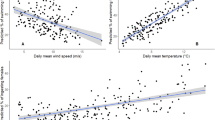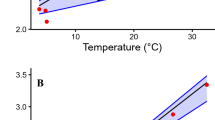Abstract
Hummingbirds are among the smallest endothermic vertebrates. Because they forage by energetically costly hovering, and because weight-specific basal metabolic rates increase with decreasing body size, their basal and active metabolic rates are among the highest recorded. Hummingbirds fuel these metabolic requirements mainly with highly concentrated sugar in nectar, which they extract rapidly and efficiently1,2 by an unknown mechanism. It is especially puzzling that, despite their high energy requirements, hummingbirds spend only ∼20% of their waking hours feeding, but 75% perched and apparently doing nothing3,4. Here we report the first measurement of nutrient absorption by hummingbird intestine and present a new method for measuring crop-emptying times. We find that hummingbird intestine has the highest active glucose transport rate and lowest passive glucose permeability reported for any vertebrate. Crop-emptying time may limit feeding-bout frequency and could largely account for the time spent perched.
This is a preview of subscription content, access via your institution
Access options
Subscribe to this journal
Receive 51 print issues and online access
$199.00 per year
only $3.90 per issue
Buy this article
- Purchase on Springer Link
- Instant access to full article PDF
Prices may be subject to local taxes which are calculated during checkout
Similar content being viewed by others
References
Hainsworth, F. R. & Wolf, L. L. Comp. Biochem. Physiol. 42A, 359–366 (1972).
Hainsworth, F. R. J comp. Physiol. 88, 425–431 (1974).
Stiles, F. G. Science 173, 818–821 (1971).
Hixon, M. A., Carpenter, F. L. & Paton, D. C. Am. Nat. 122, 366–391 (1983).
Karasov, W. H., Phan, D., Diamond, J. M. & Carpenter, F. L. Auk (in the press).
Castle, E. J. Br. J. Nutr. 10, 15–23 (1956).
Walsburg, G. E. Condor 77, 169–174 (1975).
Karasov, W. H., Rosenberg, L., Petrossian, E. & Diamond, J. M. J. comp. Physiol. (in the press).
Sibley, R. M. in Physiological Ecology: An Evolutionary Approach to Resource Use. (eds Townsend, C. R. & Calow, P.) 109–142 (Sinauer, Sunderland, 1983).
Karasov, W. H. & Diamond, J. M. comp. Physiol. 152, 105–116 (1983).
Karasov, W. H., Buddington, R. K. & Diamond, J. M. in Proc. 1st int. Congr. comp. Physiol. Biochem. Vol 2. (Springer, Berlin, in the press).
Karasov, W. H., Solberg, D. H. & Diamond, J. M. Am. J. Physiol. 249, G271 283 (1985).
Hixon, M. A. Am. Nat. 119, 596–599 (1982).
Wolf, L. L. & Hainsworth, F. R. Ecology 52, 980–988 (1971).
Ewald, P. W. & Carpenter, F. L. Oecologia 31, 277–292 (1978).
Author information
Authors and Affiliations
Rights and permissions
About this article
Cite this article
Diamond, J., Karasov, W., Phan, D. et al. Digestive physiology is a determinant of foraging bout frequency in hummingbirds. Nature 320, 62–63 (1986). https://doi.org/10.1038/320062a0
Received:
Accepted:
Issue Date:
DOI: https://doi.org/10.1038/320062a0
This article is cited by
-
Patterns of year-to-year variation in haemoglobin and glucose concentrations in the blood of nestling Pied Flycatchers Ficedula hypoleuca
Journal of Ornithology (2015)
-
Sugar flux through the flight muscles of hovering vertebrate nectarivores: a review
Journal of Comparative Physiology B (2014)
-
A review of the energetics of pollination biology
Journal of Comparative Physiology B (2013)
-
The effect of seed packaging on digestion and food preference by Purple-crested (Gallirex porphyreolophus) and Knysna (Tauraco corythaix) Turacos
Journal of Ornithology (2011)
-
Seasonal intake responses in the nectar-feeding bat Glossophaga soricina
Journal of Comparative Physiology B (2009)
Comments
By submitting a comment you agree to abide by our Terms and Community Guidelines. If you find something abusive or that does not comply with our terms or guidelines please flag it as inappropriate.



